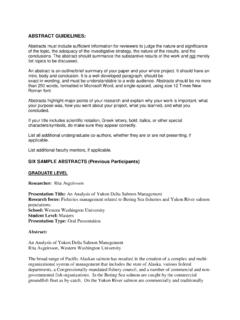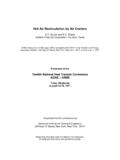Transcription of DEFORMATION OF COMPACTED FILLS - cagecolorado.org
1 GeoInstitute SeminarColorado Association of Geotechnical EngineersDEFORMATION OF COMPACTED FILLSIraj Noorany, , , , F. ASCEC onsulting Geotechnical EngineerProfessor Emeritus, San Diego State UniversitySeptember 12, 2018 Structural FILLS and Embankments- Support structures- Support improvements-Walls, fences, pools, hardscape, landscape - Tolerable differential movement- Stable slopesDesign ChallengesUnsaturated soils are complicated-Soil properties change Post-constructionwetting from landscape irrigation, precipitation, underground seepage, and underground leaks changesoil suction, water content, dry density, RC, degree of saturation, strength, moduli, Fill s geometry changes-Heave, settlement, lateral fill expansion (LFE)FocusCompacted structural fillsExpansive soilsFill DEFORMATION due to wettingSlope DEFORMATION due to wettingPractice in California and Southwest includedElastic deformationDeformation due to instability of slopesDeformation caused by earthquakeCreep deformationOther methods and practicesScopePart 1- Types of wetting-induced fill DEFORMATION Part 2- One-dimensional fill DEFORMATION - Laboratory swell-collapse tests - DEFORMATION analysisPart 3- Lateral DEFORMATION of slopes- Laboratory swell-collapse tests - DEFORMATION analysisPart 4- Mitigation of DEFORMATION of COMPACTED FILLS Part 1 TYPES OF WETTING-INDUCED FILL DEFORMATION - Significant differential movement of slabs and foundations- Heave- Settlement- Cracks in structures and slabs- Lateral stretching of fill embankments (LFE)
2 - Separations and cracks in hardscape, parallel to descending slopes- Separations and cracks in side yard walls and top of the slope fences- Damage to appurtenant structures in the vicinity of the slopeFrom Brandon, et al. 1990 WETTING PATTERNP lacement, 19841996 Typical Inclinometer Data Showing LFEPart 2 ONE-DIMENSIONAL HEAVE AND SETTLEMENTStep 1- Laboratory tests - Classification and compaction- One-dimensional swell-collapse tests Step 2- Adjustment of the measured swell-collapse strains- n1, n2, n3 Step 3- Analyze heave, settlementStep 1 One-dimensional Swell and Collapse TestTests ina large mold using the total fill material tests in small molds using the fill s finer fractionOne-dimensional Swell and Collapse TestsASTM D 4546-14- Method ATests on laboratory COMPACTED specimens- Filldesign stage, for predicting fill DEFORMATION - Forensic inverse analysis of fill DEFORMATION - Method BTests on intact undisturbed samples-Forensic analysis of existing fill, and estimating the amount of the remaining heave or settlement- Method cFor loading-after-wetting cases.
3 New loads on old fillTest Method A - Design Phase Wetting-after-loading testUse finer fraction of the representative fill material and prepare four or more laboratory- COMPACTED specimens. Use water content and dry density of the finer fraction : = = This equation is reasonably accurate for: + No. 4 oversize fractions up to 40% (P up to ), or +3/4 oversize fractions up to 30% (P up to ).Test Method A Inverse DEFORMATION AnalysisWetting-after-loading testTake intact samples of the fill from forensic borings. Remove the oversize. Reconstitute specimens using the placement water content and dry density of the finer fraction. = = This equation is accurate for+ No. 4 oversize fractions up to 40% or +3/4 fractions up to 30% . Corrections for testing system deformationsAll DEFORMATION readings must be corrected for system complianceIf filter paper is used, correct for compression of the filter paper in both dry and wet D4546-08, Method ASwell/Collapse tests on Multiple SamplesWetting-induced StrainsInitial height of specimen = hAmount of dry compression = h 1 Height of specimen before wetting = h1 = h - h 1 Amount of swell or collapse DEFORMATION = h 2 = swell strain = collapse strainStep 2- Strain Adjustment Factorsn1= Reduction factor for partial wetting effectn2= Reduction factor to account for the presenceof the inert oversize material in the filln3= Empirical factor to account for the interference of the oversize fraction with volume change of the finer fractionPartial wetting parameter.
4 N1 1= How to Estimate n1- Based on lab partial wetting tests , coupled with forensic water content or degree of saturation data in the field- Based on lab suction-controlled tests and soil-water characteristic tests , coupled with field measurements of matric suctionParameter n3- Empirical factor for the effect of interference of the large amount of oversize particles with volume change of the finer fraction - Additional research is needed for testing large COMPACTED specimens including the oversize- Use n3= 1 for soils with + No. 4 oversize fraction up to 40%, or +3/4 oversize fraction up to 30% adjusted= n1. n2. n3 measuredStep 3 Compute Heave and Settlement- Using the fill s as- COMPACTED bulk density, calculate vertical stresses at various depths; include surcharge pressures if Select the corresponding strains from the swell-collapse Plot a curve showing the swell and collapse strains with Calculate the cumulative DEFORMATION of the ground Method B- ASTM D4546-14 Forensic analysis of a partially wetted fillTake intact undisturbed samples from forensic borings; assemble samples in consolidometers; apply to each sample a single stress equal to the overburden stress plus the effect of surface loads, if any; unload and reload, measure dry compression.
5 Any difference between dry compression after the first and the second load application is indication of sample disturbance;Inundate each sample with tap water and measure the wetting-induced strain;Plot the wetting-induced strains versus fill depth, and compute the remaining heave or settlement of the fill. Apply adjustment factors n1, n2and n3, if any;Using additional intact samples, measure the in-situ water contents and plot the forensic water content profile with depth. Plot the final water contents of the tested samples with depth. Also, using the fill placement records, plot the profile of the placement water contents. Test Method CLoad-induced DEFORMATION after wetting-induced heave or settlement. Additional fill or new loads on top of an existing first part of the test is similar to Method A (reconstituted specimens), or Method B (intact samples). After inundation and after completion of swell or collapse, apply additional loads as in a consolidation test.
6 Plot the load-induced strains versus fill depth, and compute the fill DEFORMATION due to new loads. Some ComplicationsOther methods that use Method C or variations of Method C instead of Method A- Loading-after wetting consolidation test on a single specimen- Swell-consolidation (SC) test and constant swell (CS) test- Swell-consolidation (SC) test and empirical estimation of Swell Pressure- OtherMethod C- Multiple loads on one specimen(loading after wetting)Method A- Single loads on multiple specimens(wetting after loading)Comparison of Method A and Method C (Noorany 1992)Nonlinearity of Method A data in Semi-Log Plots (Rosenbalm 2013)Part 3 LATERAL FILL EXPANSION (LFE)LFE MethodStep 1-Triaxial swell-collapse tests on COMPACTED specimens;measure wetting-induced vertical and radial strains for a range of K valuesStep 2-Plot two sets of curves: wetting-induced vertical and radial strains versus major principal stressStep 3-Adjust the vertical and radial strain curves by usingn1, n2, n3as applicableStep 4-Calculate vertical and lateral deformationof different points using a finite-element or a finite-difference codeResults of Triaxial Swell/Compression TestsSoil FV-1, w= , RC=90%LFE Computation Codes 1992, SWELL by Joel Sweet-Noorany et al.
7 , 1992 1999, FLAC by ITASCA-Cundall, P. and Detournay C. 1999-Noorany et al. 1999 Results of LFE AnalysisVertical and horizontal DEFORMATION for any pointDifferential vertical and horizontal deformationsCalculations with different assumed K values Calculations with different partial wetting assumptionsLateral movement data for different setback distances from the slope crestPart 4 MITIGATION OF HEAVE, SETTLEMENT AND LFE STRUCTURAL FILLS AND EMBANKMENTSM itigation of DEFORMATION of FILLS - If feasible, use different soil types for different fill zones- Different performance-based compaction specifications for different fill zones (..subject of another talk)- Analyze different fill geometries and wetting conditions- Structural design for thick slabs and deep foundations(Nelson, et al.; Briaud, et al.)- Wide setbacks on top of descending slopes- Landscape and hardscape layouts that can accommodate LFE Shortcuts based on local experience Cost BenefitSummaryAdditional InformationSee the attached list of D 4546-14 "Standard Test Method for One-Dimensional Swell or Collapse of Soils", ASTM Book of Standard Specifications, Designation: D D 4718-87 Standard Practice for Correction of Unit Weight and Water Content for Soils Containing Oversize Particles , ASTM Book of Standard Designation: , T.
8 , Duncan, , and Gardner, W. (1990), Hydrocompression Settlement of Deep FILLS , Journal of Geotechnical and Geoenvironmental Engineering, ASCE, Vol. 116, No. , et al., (2016), Stiffened Slab-On-Grade on Shrink-Swell Soil: New Design Method , Journal of Geotechnical and Geoenvironmental Engineering, ASCE, Vol. 142, No. , P. and Detournay, C. (1999), A FLAC Implementation of Noorany Method to Model Swell/Collapse Caused by Wetting , Itasca Consulting Group, Inc. Minneapolis, MN Houston, S. L., and Houston, W. N. (1997). Collapsible Soils Engineering, . Geotechnical Special Publication No. 68, Unsaturated Soil Engineering Practice, ASCE, New York, , S. L., and Houston, W. N. (2017). Suction-Oedometer Method for Computation of Heave and Remaining Heave , Proc. ASCE Pan Am Unsaturated Soils Conference, Dallas, Texas. Justo, J. L., Delgado, A., and Luiz, J. (1984). The Influence of Stress-Path in the Collapse-Swelling of Soils at the Laborator y, Proc.
9 5th Int on Expansive Soils, , , Chao, , Overton, and Nelson, (2015). Foundation Engineering for Expansive Soils, John Wiley & Sons, New York, , I. (1992). "Stress Ratio Effects on Collapse of COMPACTED Clayey Sand", Discussion, Journal of Geotechnical Engineering, ASCE, Vol 118, , I., Sweet, J. A. and Smith, I. M. (1992). " DEFORMATION of Fill Slopes Caused by Wetting". Proceedings of the ASCE Conference on Stability and Performance of Slopes and Embankments II, ASCE Geotechnical Special Publication No. 31, Berkeley , I. and Stanley, J. V. (1994). "Settlement of COMPACTED FILLS Caused by Wetting" Proc. Vertical and Horizontal Deformations of Foundations and Embankments, ASCE,Vol 2 ASCE Settlement '94 Conference, College Station , I. and Houston, S. (1995). "Effect of Oversize Particles on Swell and Compression of COMPACTED Unsaturated Soils". Geotechnical Special Publication No. 56, Static and Dynamic Properties of Gravelly Soils.
10 ASCE, New York, , I. and Scheyhing, C. (2015). Lateral Extension of COMPACTED -Fill Slopes in Expansive Soils , Journal of Geotechnical and Geoenvironmental Engineering, Vol. 141-No. , I. (2017). Soil tests for Prediction of One-Dimensional Heave and Settlement of COMPACTED FILLS , Proc. ASCE Pan Am Unsaturated Soils Conference, Dallas, Texas. Rosenbalm, D. C. (2013). "Volume Change Behavior of Expansive Soils Due to Wetting and Drying Cycles", Thesis, Arizona State , , and Wilks, (2017). Post-Construction DEFORMATION of COMPACTED FILLS Caused by Wetting , Presented at ASCE Geotechnical Frontiers 2017, Geotech. Special Publication 280.




